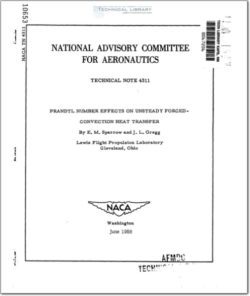NACA-TN-4311

- Version
- 175 Downloads
- 696.22 KB File Size
- 1 File Count
- December 4, 2015 Create Date
- December 4, 2015 Last Updated
National Advisory Committee for Aeronautics, Technical Notes - Prandtl Number Effects on Unsteady Forced Convection Heat Transfer

An analysis is made for laminar forced-convection heat transfer on
a flat plate with unsteady surface temperature. The deviation of the
instantaneous heat-transfer rate from the quasi-steady value is computed.
Results are obtained for Prandtl numbers in the range 0.01 to 10. The
deviations from quasi-steady heat transfer increase markedly with in-
creasing Prandtl number. The findings reported here should apply approx-
imately in the entrance region of ducts and should also provide an upper
bound on deviations from turbulent quasi-steady heat transfer.
It is often necessary to compute the forced-convection heat trans-
fer from a surface whose temperature is changing with time. This problem
is much simplified when it is supposed that the boundary layer passes
through a succession of instantaneous steady states. Such a boundary
layer is called quasi-steady. Under this assumption, the heat transfer
is computed by instantaneous application of steady-state heat-transfer
relations. The quasi-steady supposition is also invoked in heat-transfer
experiments employing the transient technique, where the instantaneous
measurements are used to determine steady-state coefficients.
In reality, there is always a difference between the actual instan-
taneous heat transfer and the quasi-steady value. The extent of the
deviation depends upon the response characteristics of the boundary
layer, as well as on the rapidity of the changes in surface temperature.
The aim of this analysis is to find the first- and second—order de-
viations of the actual instantaneous heat transfer from the quasi-steady
value and to learn how these deviations depend upon the Prandtl number.
The final results provide a rapid and accurate quantitative means for
determining when a given set of surface temperature and free-stream ve-
locity data lead to essentially quasi-steady heat transfer.
| File | Action |
|---|---|
| naca-tn-4311.pdf | Download |

Comment On This Post